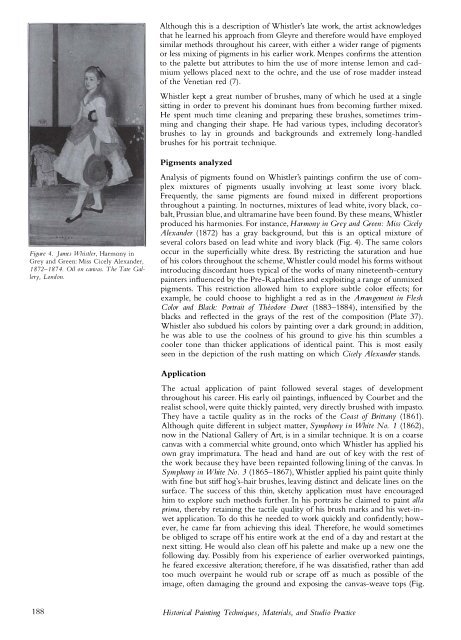Historical Painting Techniques, Materials, and Studio Practice
You also want an ePaper? Increase the reach of your titles
YUMPU automatically turns print PDFs into web optimized ePapers that Google loves.
Although this is a description of Whistler's late work, the artist acknowledges<br />
that he learned his approach from Gleyre <strong>and</strong> therefore would have employed<br />
similar methods throughout his career, with either a wider range of pigments<br />
or less mixing of pigments in his earlier work. Menpes confirms the attention<br />
to the palette but attributes to him the use of more intense lemon <strong>and</strong> cadmium<br />
yellows placed next to the ochre, <strong>and</strong> the use of rose madder instead<br />
of the Venetian red (7).<br />
Whistler kept a great number of brushes, many of which he used at a single<br />
sitting in order to prevent his dominant hues from becoming fu rther mixed.<br />
He spent much time cleaning <strong>and</strong> preparing these brushes, sometimes trimming<br />
<strong>and</strong> changing their shape. He had various types, including decorator's<br />
brushes to lay in grounds <strong>and</strong> backgrounds <strong>and</strong> extremely long-h<strong>and</strong>led<br />
brushes for his portrait technique.<br />
Pigments analyzed<br />
Figure 4. James Whistler, Harmony in<br />
Grey <strong>and</strong> Green: Miss Cicely Alex<strong>and</strong>er,<br />
1872- 1874. Oil on canvas. The Tate Gallery,<br />
London.<br />
Analysis of pigments fo und on Whistler's paintings confirm the use of complex<br />
mixtures of pigments usually involving at least some ivory black.<br />
Frequently, the same pigments are found mixed in different proportions<br />
throughout a painting. In nocturnes, mixtures of lead white, ivory black, cobalt,<br />
Prussian blue, <strong>and</strong> ultramarine have been found. By these means, Whistler<br />
produced his harmonies. For instance, Harmony in Grey <strong>and</strong> Green: Miss Cicely<br />
Alex<strong>and</strong>er (1872) has a gray background, but this is an optical mixture of<br />
several colors based on lead white <strong>and</strong> ivory black (Fig. 4) . The same colors<br />
occur in the superficially white dress. By restricting the saturation <strong>and</strong> hue<br />
of his colors throughout the scheme, Whistler could model his fo rms without<br />
introducing discordant hues typical of the works of many nineteenth-century<br />
painters influenced by the Pre-Raphaelites <strong>and</strong> exploiting a range of unmixed<br />
pigments. This restriction allowed him to explore subtle color effects; fo r<br />
example, he could choose to highlight a red as in the Arrangement in Flesh<br />
Color <strong>and</strong> Black: Portrait


